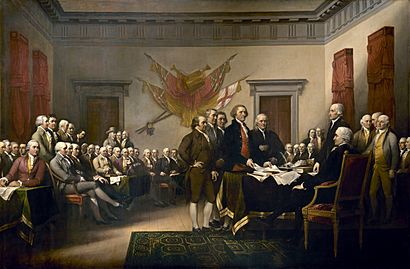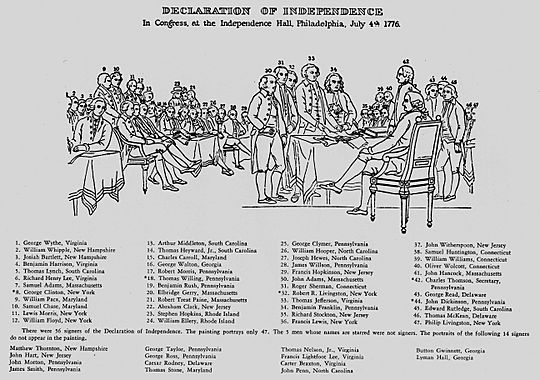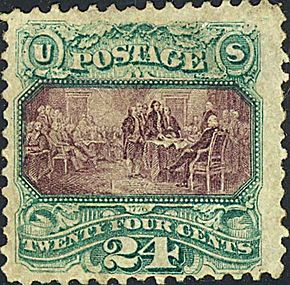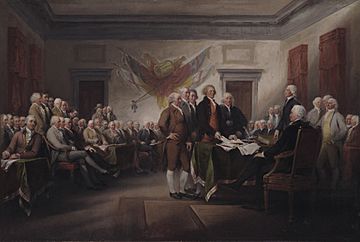Declaration of Independence (painting) facts for kids
Quick facts for kids Declaration of Independence |
|
|---|---|
 |
|
| Artist | John Trumbull |
| Year | commissioned 1817; purchased 1819; date of creation 1818; placed in the Rotunda 1826 |
| Medium | Oil-on-canvas |
| Dimensions | 3.7 m × 5.5 m (12 ft × 18 ft) |
| Location | U.S. Capitol, Washington, D.C., U.S. |
The Declaration of Independence is a famous oil-on-canvas painting by American artist John Trumbull. It shows an important moment in American history. The painting is about 12 by 18 feet in size.
It shows the Committee of Five presenting the first draft of the Declaration of Independence to the Second Continental Congress. This event happened on June 28, 1776. Many people think the painting shows the signing of the Declaration, but that happened later, mostly on August 2.
John Trumbull worked hard to make the painting accurate. He painted many of the people from real life. He even visited Independence Hall to see the room where the Congress met. The U.S. government asked Trumbull to create this painting in 1817. It was placed in the United States Capitol rotunda in 1826.
Contents
What the Painting Shows
The painting features 42 of the 56 men who signed the Declaration. Trumbull wanted to include all 56 signers. However, he could not find pictures or likenesses for everyone. He also included some people who were part of the debate but did not sign. One example is John Dickinson, who chose not to sign.
Trumbull did not have a portrait of Benjamin Harrison V. So, he painted Harrison's son, Benjamin Harrison VI, who looked like his father. He did the same for Stephen Hopkins, using his son Rufus Hopkins as a model. Because the Declaration was debated and signed over time, the men in the painting were never all in the same room at once.
If you look closely, it might seem like Thomas Jefferson is stepping on John Adams' shoe. Some thought this showed they were rivals. But if you look closer, their feet are just very close together. This detail is shown correctly on the two-dollar bill.
On the back wall of the painting, you can see trumpets, a drum, and flags. These were captured from British army groups during the American Revolutionary War. This detail is not shown in all versions of the painting, like the one on the two-dollar bill.
Who's Who in the Painting
This painting shows many important figures from American history. You can click on the image below to learn who each person is.
The five men standing in the center of the painting are the Committee of Five. They were chosen to write the Declaration of Independence. They are:
- John Adams
- Roger Sherman
- Robert R. Livingston (who did not sign the final Declaration)
- Thomas Jefferson
- Benjamin Franklin
John Hancock, who was the president of the Continental Congress, is shown seated at the central table. Charles Thomson, the secretary of the Congress, is standing next to him.
On U.S. Money and Stamps
Trumbull's Declaration of Independence painting has appeared on United States money and postage stamps many times. It was first seen on the back of a $100 National Bank Note in 1863. Six years later, it was used on a 24-cent postage stamp.
Today, you can see a part of Trumbull's painting on the back of the two-dollar bill. This version shows 40 of the 47 figures from the original painting. Some figures on the far left and right were left out. Also, two new, unrecognized figures were added. This brings the total number of people on the two-dollar bill version to 42.
Other Versions of the Painting
John Trumbull painted a smaller version of this scene. It is called The Declaration of Independence, July 4, 1776. This painting is much smaller, about 20 by 31 inches. You can see it today at the Yale University Art Gallery in New Haven, Connecticut.
See also
 In Spanish: Declaración de Independencia (John Trumbull) para niños
In Spanish: Declaración de Independencia (John Trumbull) para niños
- Congress Voting Independence, a similar painting by Robert Edge Pine
- Scene at the Signing of the Constitution of the United States – a painting showing the signing of the U.S. Constitution
- Founding Fathers of the United States
- Syng inkstand, an inkwell shown in the painting







